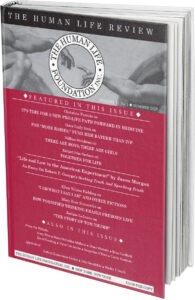Let There Be Light
Researchers at the University of Waikato in New Zealand are studying how light from the outside world travels into the womb. A pregnant woman’s skin allows light to pass through and provide some illumination, and strong light applied directly to her skin can illuminate the womb to the degree of a full moon in clear conditions! The research team includes Professor Vincent Reid, a developmental cognitive neuroscientist, who says: “. . . it’s definitely not dark in there.” Jamie Morgan, MD, of UT Southwestern Medical Center writes about how Reid and his colleagues have studied the reaction of third-trimester fetuses to patterns of red dots shone into the uterus, monitored using high-definition ultrasound. They found, she reports, that the pre-born were about twice as likely to track the movement of dot patterns that resemble a human face, the same as with babies after birth. Professor Reid’s focus is on how humans develop perception and cognition in the first few years of life—and before birth. “Many researchers,” he says, “including myself, have spent decades working with infants to understand how human perception and social development works. Our growing understanding of the uterine environment means we are learning that much of this experimental work with infants can be moved into understanding the third trimester.”
How refreshing to see—in sharp contrast to self-serving pro-abortion rationales about how “it’s not a baby”—studies of human infancy being backdated to life in the womb. Dr. Morgan also tells us how the other senses, touch, smell/taste and hearing, are present and develop much sooner than the third trimester; in fact, those in the womb explore their world from a very early gestational age. Touch is the first sense to form. Beginning at around eight weeks with sensory receptor development on the lips and nose, it then proceeds to other parts of the body, palms and soles by 12 weeks and the abdomen by 17 weeks. Taste and smell are interwoven because the sense of taste is 90 percent smell. The flavors vanilla, carrot, garlic, anise and mint are transmitted into amniotic fluid, which babies not only live in but routinely drink several ounces of per day. In one experiment a group of pregnant women was instructed to drink carrot juice every day while another group was told to avoid it. Once born and eating solid food, the children were fed cereal made with either water or carrot juice, and those who had been exposed to carrot in amniotic fluid preferred carrot flavored cereal.
It was first established in the 1980s that babies in the womb are likely to hear and identify voice patterns. By attaching a nonnutritive nipple to a tape recorder, Dr. Morgan reports, one study showed newborns would suck more when listening to their mother’s voice compared to when they were played a tape of a stranger speaking. In a subsequent experiment, women were asked to read The Cat in the Hat to their fetuses repeatedly for the last seven weeks of their pregnancies. After they were born, infants were played two recordings, one of mom reading The Cat in the Hat, the other of her reading a different children’s book. “The babies showed a consistent preference for the recording of The Cat in the Hat,” says Dr. Morgan, “presumably based on their prenatal experience.”
Since these initial studies, more research has been published suggesting fetuses are even able to learn in utero. Zounds! Forget about pre-school, imagine a classroom full of pregnant ladies with a bespectacled professor lecturing to their bellies! Seriously though, all this makes it clear that the baby keenly responds to our external world long before he or she enters it. Encountering their world through taste, touch, and hearing from a very early gestational age, and sight in the third trimester, means fetuses are experiencing life, and although a microcosm of an adult—who can explore the woods, enjoy a new recipe, discover a great new garage band, or simply gaze at the full moon—fetuses are still in the being alive column.
A contentious topic in the abortion debate is whether the baby being aborted can feel pain, and it’s present in both pro-choice and pro-life positions. The ability to feel pain at 15 weeks has been the basis for banning abortion after that point, whereas according to the American College of Obstetricians and Gynecologists (ACOG) a fetus isn’t capable of feeling pain until at least 24-25 weeks, and since 93 percent of abortions are done at or before 13 weeks, the issue of pain for the baby, when compared to the “social justice” of a woman’s right to choose, is ostensibly negligible. If I may throw my two cents in—the pain argument is ultimately moot. Fetuses can be killed by injection before the abortion procedure. Euthanasia is painless. Execution by lethal injection is designed to be painless. Execution in the gallows breaks the neck and causes immediate loss of consciousness. Abortion is principally about life being taken, including that of the newly conceived; if there’s no elective abortion there’s no pain to be rationalized.
The cornerstone of abortion on demand for any reason is that an individual’s independence supersedes that of the unborn under all circumstances, and since maybe painless, doesn’t matter much anyway. This strategy of willful blindness is like watching a toddler play hide-and-seek before they’ve grasped the ground rules: They “hide” by standing in full view of everyone with their hands over their eyes believing because they can’t see anybody, nobody can see them.
Open your eyes.










